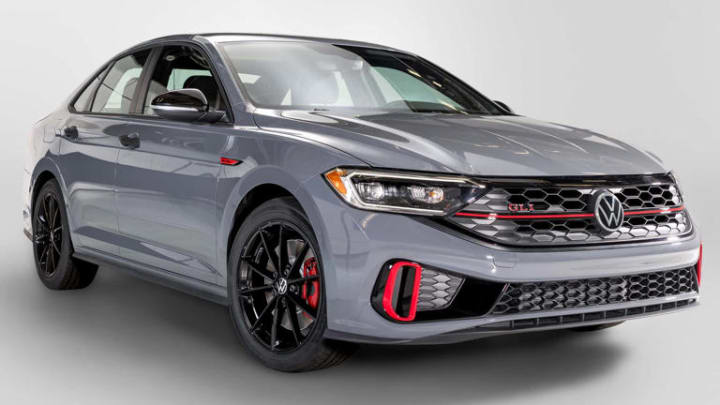

In 1984, Volkswagen introduced the Jetta GLI in the US for buyers who wanted the GTI's powertrain in a sedan. The 2024 GLI 40th Anniversary Edition is limited to 1,984 US units. After the $1,150 destination fee, the model costs $29,235.
The 40th Anniversary Jetta GLI comes in Pure Gray, Pure White, and Rising Blue. They have black grilles, mirror caps, and tiny rear spoilers. Nose and badges have red accents.
The special edition has black 10-spoke 18-inch wheels. Their brakes are red.
The 40th Anniversary Edition's cloth seats have asymmetrical debossed centers. The chairs have "GLI 40" tags and red piping. GLI and 1984 are on the cupholders. Steering wheel spoke six has a "40" logo.The 40th Anniversary Edition GLI Autobahn's powertrain is unchanged. The sedan gets a turbocharged 2.0-liter four-cylinder with 228 horsepower and 258 pound-feet. Six-speed manual and electronic differential lock.After destination, a seven-speed dual-clutch gearbox costs $30,035.
The 1984 VW Jetta GLI's 1.8-liter four-cylinder produced 90 horsepower and 100 lb-ft. For an entry-level sport sedan, it was competitive. For 1988, a 16-valve version produced 123 hp.
For the fourth-generation Jetta, VW revived the GLI name. Like the original, it used the VR6 and 1.8-liter turbocharged four-cylinder from the GTI hatchback.The Jetta has been available as a four- or five-seater two-door saloon, four-door sedan, and five-door wagon/estate. Each generation of the car has grown in size and power since 1980.[1] Nearly 10 million Jettas were sold worldwide by mid-2011. Volkswagen sold over 14 million in April 2014, becoming its best-selling model.[2]
Nameplate origin
The Volkswagen Passat (after the German word for trade wind), Volkswagen Bora (after bora), and Volkswagen Scirocco (after sirocco) were named after prominent winds and currents, as was the Jetta.[3]
A 2013 report by former VW advertising copywriter Bertel Schmitt found no evidence that Volkswagen used a naming theme for its front-drive, water-cooled vehicles, nor that the names derived from a theme, nor that a naming system "was ever announced, either officially or confidentially."Second generation (1984)
Jetta 4-door (USA)
VW Jetta (A2)
Mark 2 Jettas are the longest-running. Volkswagen's second-generation Jetta sold well in Europe and North America after its 1984 and 1985 debuts. The Farmer's Journal COTY 1991 winner outsold the Golf by two-to-one in North America.[18] Based on the all-new second-generation Golf platform, the car was larger, heavier, and could seat five instead of four like the Mark 1. All exterior dimensions grew. The length increased 100 mm (3.9 in), the wheelbase 66 mm (2.6 in), and the width 53 mm (2.1 in). The suspension was mostly unchanged from the first generation, but it was improved by adding a subframe for mounting the front control arms to reduce noise and better rubber mountings for all components. Drag coefficient 0.36 improved aerodynamics.The trunk had a 470-litre (16.6 ft3) luggage compartment, nearly as large as some full-sized American sedans.[20] Interior space increased 14%, changing the EPA class from sub-compact to compact.
German cars were assembled in Wolfsburg's new Assembly Hall 54. The plant was heavily robotized to improve build quality.[21] On the second generation, an optional trip computer (the MFA, German Multi-Funktions-Anzeige) and silicone-damped engine and transmission mounts reduced noise, vibration, and harshness. Fully electronic fuel injection was introduced in 1988. Digifant engine management system.
Like the Mark 1, the second generation was a two- or four-door sedan. In 1988, the front-quarter windows were removed, and in 1990, body-colored bumpers and lower side skirts were added.
Volkswagen of America held a 2007 contest to find the diesel-powered Volkswagen with the longest original engine mileage.[22] A 1986 Blue Rock, Ohio Jetta Turbodiesel with 562,000 miles (904,000 km) won.[23] Local dealers verified the odometer. Despite being in a winter road salt area, this car had the original muffler.
Third generation (1992)
Jetta (USA)
Volkswagen Vento (A3)
In 1992, the third-generation Jetta was renamed the Volkswagen Vento in Europe, following the trend of naming cars after winds. After Volkswagen plant delays and quality issues in Puebla, Mexico, the Jetta 3 debuted in North America in 1993.[24] "Vento" means "wind" in Portuguese and Italian. It was released in most of Europe in the first quarter, but not in Britain until September 1992.
Volkswagen kept the Jetta nameplate after its second-generation success in North America. In Europe, the car was renamed to attract younger buyers.[25]
Herbert Schafer's design team again made the car more aerodynamic. Underneath the Mark 2's appearance were many improvements. The two-door model was discontinued and aerodynamics improved to 0.32.[26] The new structure met global crash standards.[27] Suspensions were mostly a wider track and backwards compatible with previous editions. Recycled plastics, CFC-free air conditioning, and heavy metal-free paint made the car greener.[28]
This car generation is credited with keeping Volkswagen in North America.[24][29] Volkswagen of America's sales hit a 50-year low in 1993. That year, the division sold 43,902 cars. Puebla plant issues slowed sales.[30] However, sales rebounded dramatically in the following years, mostly due to the Jetta, which remained the best-selling Volkswagen in the US.[31]
Fourth generation (1999)
VW Bora (UK)
VW Bora
Fourth-generation car production began in July 1999.[32] The car was called the Volkswagen Bora worldwide, continuing the wind theme. Bora is a winter wind that blows intermittently over the Adriatic Sea, Greece, Russia, Turkey, and Sliven, Bulgaria. North America and South Africa kept the Jetta name due to its popularity.
The Mk4 followed the Passat, which it resembled. The new Volkswagen style was rounded corners and an arched roofline. The Mk4's Whiptenna, a trademark for the antenna on the roof's rear end, is shorter and leeward than traditional antennas, reducing drag. For the first time, rear passenger doors differed from 5-door Golfs. The estate/wagon version had non-interchangeable rear doors. This generation introduced rain sensor-controlled windshield wipers and automatic climate control. However, these were expensive extras, so the used market has many sparsely equipped models.
Although shorter than the Mark 3, the fourth generation had a longer wheelbase. Powertrain options survived. However, the 1.8-litre turbo 4-cylinder and VR6 were new internal combustion engines. The suspension was similar. However, most models softened it to provide a comfortable ride, but it was still hard compared to rivals like French cars.[33]
Fifth generation (2005)
Jetta (A5)
Volkswagen Jetta (A5)
On January 5, 2005, the fifth-generation debuted. It was Volkswagen's second U.S. auto show debut after the New Beetle.[34] Volkswagen prioritized the US market for the Mark 5 sedan, launching it first.[35]
The fifth generation is called Jetta in most markets, Bora in Mexico and Colombia, Vento in Argentina and Chile, and Sagitar in China.[36][37][38] The Mark 5 is longer, wider, and has a longer wheelbase than its predecessor. Interior space increased from 2.46 to 2.58 cubic metres (87 to 91 cu ft). Over the fourth generation, rear legroom increased 65 mm (2.6 in). 453 litres (16 cu ft) luggage capacity. Jettas now have the first multi-link independent rear suspension. The rear suspension resembles the Ford Focus.[39] Volkswagen reportedly hired Ford engineers who designed the Focus suspension.[33]
The Volkswagen Golf Mk5 R32's chrome front grille was adopted by other models.[40] Some critics liked the new styling, while others called it bland like the 4th generation.[41][42]
Mexico produces the most. VW invested US$800 million in Puebla's production facilities for this model. A US$290 million new engine production line for the 5-cylinder power plant, a US$50 million press shop investment, and 460 robots for US$200 million increased automation by 80%. China and South Africa finished A5 assembly for those markets.[43] Asian and African plants build the car from a Puebla factory-shipped CKD kit, like China did for the second generation. Kaluga, Russia, began local assembly in early 2008.[44] The Aurangabad Škoda factory started production in 2008.[45][46]
Sixth generation (2010)
Jetta (A6)
Volkswagen Jetta (A6)
On June 16, 2010, Volkswagen announced the sixth-generation Jetta in North America, formerly known as the NCS (New Compact Sedan).[47] The A6 Jetta ditched the Golf's sedan bodywork. It shares the Golf Mk6's PQ35 platform. As part of Volkswagen's goal of 800,000 North American sales by 2018, the new model was larger and cheaper to make, making it more competitive against mainstream compact car rivals.[48][49] Volkswagen Mexico under Volkswagen Germany designed the sixth-generation Volkswagen Jetta.[47][50]
Volkswagen's goal of increasing North American sales eliminated the Jetta's premium compact car market. The North American models had to use lower-quality interior trim and leatherette as an optional seating upholstery to cut costs. Canadian models had leather. North American models lost the multi-link rear suspension.[51] At the 2012 North American International Auto Show, the turbo hybrid was introduced.
About the Creator
Wayne
Am wayne, a writer from kenya specified in research and article writing. I love doing research on natural things, football updates and updating what going on in the world





Comments
There are no comments for this story
Be the first to respond and start the conversation.